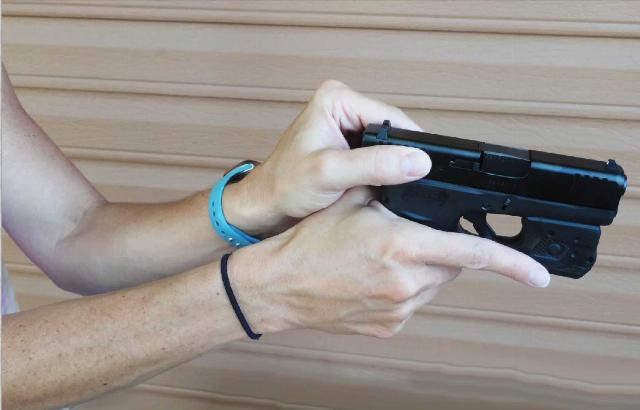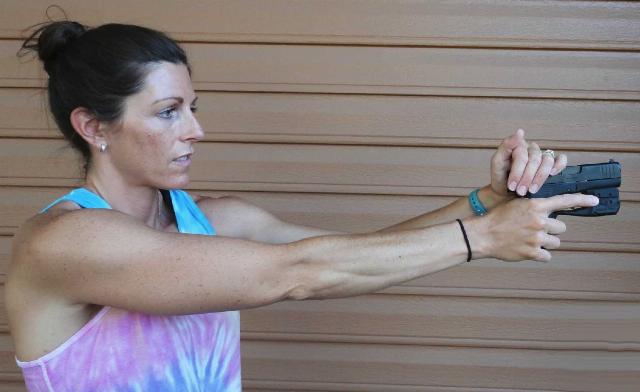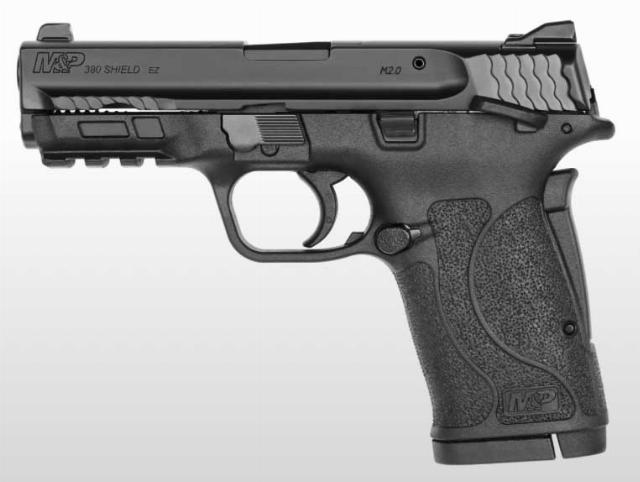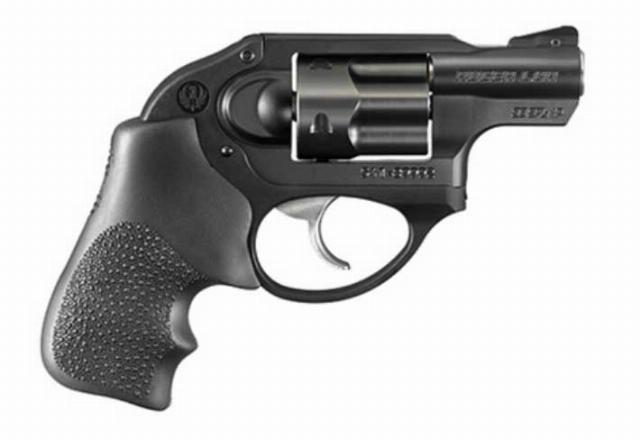Revolvers for women aren't such a great idea
All too often I see well-intentioned men decide the women in their lives are too weak to cycle the slides of contemporary semiautomatic handguns. Their solution is inevitably to guide them into revolvers, and almost always, small, concealable revolvers.
With the exception of people who have abnormally little strength, or are afflicted with a neural or muscular deficit, virtually anyone, including women and girls, has sufficient strength to cycle the slide of just about any semiauto on the market, including the most popular concealed carry handguns like a Sig P365, Glock 43 or 43X, and even larger handguns. It’s an issue I’ve explained in detail here. What’s required is not so much strength, but proper technique.

Graphic: Author
This is an example of poor, yet all too common, slide cycling technique. Only the strength of the thumb and a little of the first finger is available. Here’s the proper way:

Graphic: Author
Notice the Weaver stance, which helps keep the weapon pointed downrange. In this case, all four fingers are pressing against the palm, more efficiently using the strength of the hand. Weaver also employs a push/pull effect, where the shooting hand is pushing forward and the off hand is pulling backward. This too makes slide cycling easier. This technique should also be used—not the slide release—to release the slide to chamber a round. All slide cycling should also be energetic. You’re trying to duplicate the forces generated by firing; you won’t hurt the gun. Proper technique will ensure complete chambering and reliability.
Note the Glock 43 depicted, like many semiautos, has grooves in the slide at the muzzle. Don’t use them! Always keep your hands away from the muzzle of any firearm.
In decades of teaching women to shoot, I’ve yet to meet one who, using correct technique, could not cycle any semiauto handgun slide. To be sure, some had to work harder than others, but no one was unable.

Graphic: S&W Shield EZ. Smith & Wesson.
If one would like an easier cycling handgun, Smith & Wesson makes many models in their “EZ” series. These are handguns designed to work with less cycling force but also include, 1911-style, a grip safety, which does take a bit of practice to activate without fail.
Even older women need not worry. My wife, at 76, has no difficulty cycling slides, including those on the variety of makes and models of semiautos we own.
Contemporary revolvers useful for personal defense come in two types: double action and double action only. Double action revolvers work in one of two ways: a long, heavy—12 to 15 pounds--double action trigger pull activates internal mechanical linkage that revolves the cylinder, aligning a cartridge with the barrel, simultaneously cocking the hammer and letting it fall to strike the firing pin, firing the cartridge. The cartridge under the hammer at rest will not be the cartridge fired. Or one can manually cock the hammer, which also revolves the cylinder. This produces a very short, and lighter trigger pull, which enhances accuracy, but is inherently more dangerous as it increases the probability of negligent discharges under stress.
Double action only mechanisms are normally found on the kinds of revolvers thought to be better for women: small, light, more concealable designs. In these designs, the hammers aren’t visible or accessible; it’s impossible to fire them single action, so they always have a long, heavy trigger pull. The primary reason they lack single action ability is their hammers tend to catch on clothing when carried concealed.
Long, heavy revolver trigger pulls, which many think a safety feature, make accuracy far harder than the shorter, lighter trigger pulls of semiautomatics such as Glocks with their standard 5.5 pound triggers and much shorter trigger travel. Small double action only revolvers, while easier to conceal also have substantially greater recoil than full-sized revolvers, greater muzzle blast due to their 2” barrels, and hold only five, rather than the standard six of larger revolvers. These revolvers also virtually never have adjustable rear sights, but instead have only a groove cut or molded into the top strap.

Graphic: Ruger LCR. Ruger.
While small, double action only revolvers are easier to conceal, their limited ammunition capacity, strong recoil and muzzle blast, light weight, long, heavy trigger pulls and minimal sights make them difficult for anyone, and particularly women, to use effectively. In a very real sense, they’re expert’s guns, limited in range.
An in-depth revolver primer may be found here.
Revolvers can be effective weapons, and experts can make them do amazing things, but the choice of any defensive arm should be made not on the limitations of ineffective technique, but on accurate knowledge of its strengths and weaknesses.
Mike McDaniel is a USAF veteran, classically trained musician, Japanese and European fencer, life-long athlete, firearm instructor, retired police officer and high school and college English teacher. He is a published author and blogger. His home blog is Stately McDaniel Manor.
FOLLOW US ON
Recent Articles
- New York Greenlights Quarantine Camps
- Reality Check for Democrats
- A MAGA Siege of the Democrats’ Deep State
- Why Incel and 4B Culture Matter
- Defending Donald Trump: A Response to Jeffrey Goldberg and The Atlantic on the Signal Leak
- Are Judges Complicit in Lawfare?
- Deep Dive: The Signal Chat Leak
- Mark Steyn’s Reversal of Fortune
- Where We Need Musk’s Chainsaw the Most
- Trump Is Not Destroying the Constitution, but Restoring It
Blog Posts
- Knife control comes to the U.K.: Prime Minister Starmer bans Ninja swords
- This Tuesday, Wisconsonites must vote for Brad Schimel for the State Supreme Court
- Democrats should get a clue from the Palestinians who are now marching against Hamas
- Trump takes on Fauxahontas's brainchild
- Consumer Sentiment Survey: This too shall pass
- If they only had knife control....
- Newsom and Walz struggle to appear normal
- Anti-Trump lawfare: yes, it's a conspiracy
- Criminal attack? You're on your own.
- Amid disaster, watch Bangkok clean up and rebuild
- Katherine Maher shoots herself, and NPR, in the foot
- A visit to DOGE
- You just might be a Democrat if ...
- Yahoo Finance writer says Trump’s tariffs will see America driving Cuban-style antique cars
- Kristi Noem and the prison cell






